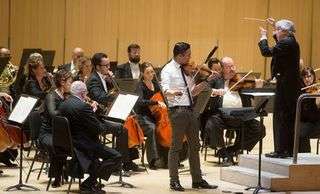|
Back
A bravura conclusion Toronto
The George Weston Recital Hall
01/19/2018 - & January 20, 21*, 2018 (Koerner Hall)
Wolfgang Amadeus Mozart: Adagio in E Major for Violin and Orchestra, K. 261 – Rondo for Violin and Orchestra, from Serenade No. 7 in D Major, K. 248b [250] “Haffner” – Piano Concerto No. 23 in A Major, K. 488 – Symphony No. 41 in C Major, K. 551 “Jupiter”
Adrian Anantawan (violin), Charles Richard-Hamelin (piano)
The Toronto Symphony Orchestra, Peter Oundjian (conductor) 
A. Anantawan, P. Oundjian (© Jag Gundu)
The TSO’s 14th annual Mozart festival came to a bravura close with this program, performed four times in 44 hours as Peter Oundjian pointed out in his introductory remarks.
The program opened with two single movements from separate works for violin and orchestra, featuring Adrian Anantawan. He is noted as the violinist who has managed to pursue a successful career despite being born with no right hand. The question that arises is: just how well does he play? Judging from these two movements, really very well. The Adagio K. 261 (composed as an alternative slow movement for Mozart’s Violin Concerto No. 5) had a beautiful flow, while the scurrying Rondo (the fourth movement of the eight-movement Haffner Serenade), was wonderfully sustained, especially the cadenza.
Charles Richard-Hamelin placed second in the 2015 at the International Chopin Competition in Warsaw, where he also won the Krystian-Zimerman Prize for the best performance of a Chopin sonata. I had never heard him before today’s performance and I was very impressed. The opening movement of Mozart’s 23rd Concerto makes demands both small-scale (with endless rippling runs) and large-scale (in structure - Peter Oundjian of course helped master this aspect). Here again there was an intriguing cadenza. The pensive Adagio and playful third movement were also thoughtfully handled.
Richard-Hamelin’s way with Chopin obviously carries over to his handling of Mozart. I suspect he will be a fixture of the piano scene for some time to come.
The Jupiter Symphony is regarded as one of the great masterworks of all time, and Oundjian and the orchestra gave a performance that truly integrated the various elements of the symphony’s intricate structure. The work presents a massive amount of musical “information” right from the start. Kevin Bazzana’s notes point out the instability and emotional tension of the slow movement, which was given a probing performance. The exhilarating final movement, with its six intertwined themes, had a racing quality; it could have degenerated into a scramble but emerged splendidly well-knit.
This was Peter Oundjian’s final stint in the Mozart Festival and it certainly brought home the fact that in his 16 years here he has nurtured a very fine approach to the classical era, whether during the annual festival or scattered throughout the season. The TSO is entering a period of uncertainty under an interim CEO (while a new one is sought) and for the next two seasons under an interim Artistic Director, namely Sir Andrew Davis. Davis is Conductor Laureate of the TSO, having been Music Director from 1975 to 1988 and then returning many times since. Let’s hope the orchestra’s sparkling and insightful way with Mozart is maintained.
Michael Johnson
|